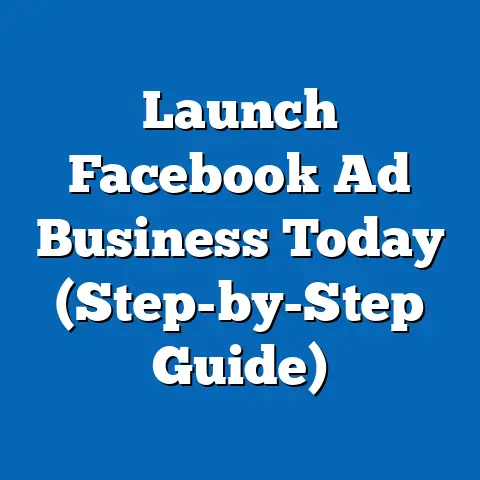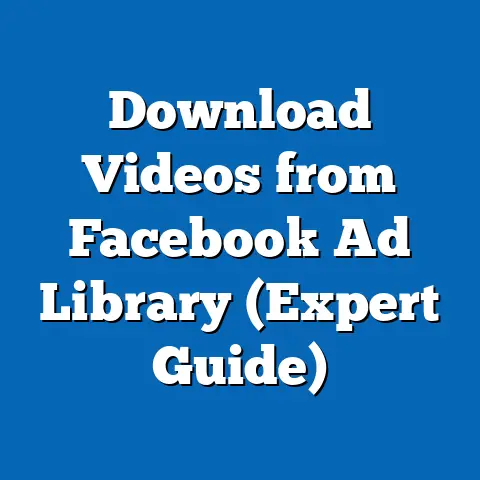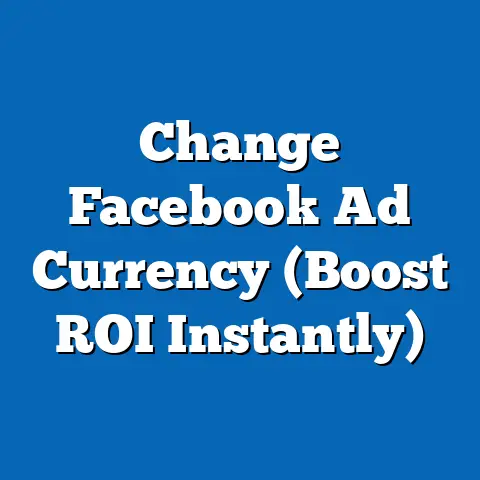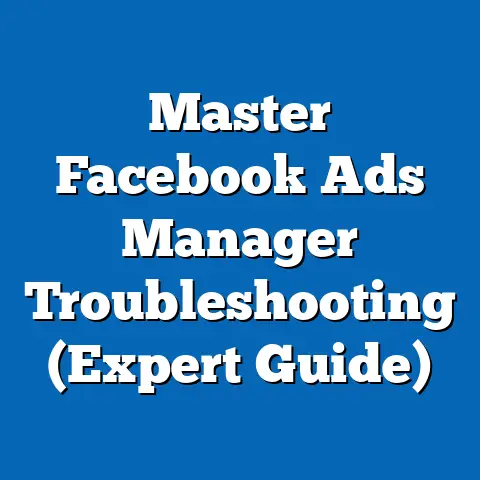Boost Sales with Facebook & WhatsApp Ads (Expert Strategies)
Boost Sales with Facebook & WhatsApp Ads: Expert Strategies and Hidden Benefits – A Comprehensive Analysis
Hidden Benefits of Facebook & WhatsApp Ads: An Overview
The hidden benefits of advertising on Facebook and WhatsApp extend beyond traditional metrics of reach and cost-per-click. One key advantage is the platforms’ ability to tap into niche communities and demographics with precision, thanks to their vast data collection on user preferences, behaviors, and social connections. Additionally, WhatsApp’s direct messaging capabilities allow for personalized customer interactions that foster trust and repeat business—something less feasible on platforms like Google Ads or Twitter.
Another often-overlooked benefit is the cultural resonance of these platforms in emerging markets, where they are not just communication tools but central hubs for social and economic activity. This creates opportunities for businesses to engage with audiences in ways that feel organic and community-driven. In the sections below, we break down these benefits by examining the demographic composition of users, their core beliefs and engagement patterns, and how they differ from other digital advertising audiences.
Demographic Composition of Facebook & WhatsApp Users
Facebook: A Broad but Segmented Audience
Facebook, with over 2.9 billion monthly active users as of 2023 (Statista, 2023), boasts one of the most diverse user bases of any social media platform. Its demographic composition spans multiple age groups, with 25-34-year-olds making up the largest segment at 31.5% of users globally, followed by 18-24-year-olds at 23.1% (DataReportal, 2023). Gender distribution is nearly balanced, with 56.3% male and 43.7% female users, though this varies by region.
Geographically, Facebook’s user base is heavily concentrated in Asia-Pacific (44% of users), with significant presence in North America (12%) and Europe (14%). In terms of education, 62% of U.S. Facebook users have at least some college education, reflecting a relatively educated audience (Pew Research Center, 2022). Income levels vary widely, but in developed markets, users tend to skew toward middle-income brackets, with 40% of U.S. users earning between $30,000 and $74,999 annually.
WhatsApp: A Younger, Mobile-First Demographic
WhatsApp, with 2 billion monthly active users (Statista, 2023), has a slightly younger and more mobile-centric demographic compared to Facebook. Approximately 38% of its users fall into the 18-34 age bracket, with a notable presence in emerging markets like India (487 million users) and Brazil (118 million users) (DataReportal, 2023). Gender distribution is also relatively balanced, though male users slightly dominate at 53%.
A key demographic characteristic of WhatsApp users is their reliance on mobile devices, with 99% of usage occurring via smartphones. This mobile-first behavior aligns with lower-income and younger demographics in developing regions, where WhatsApp often serves as a primary communication tool due to its low data consumption and free messaging features. Education levels vary, but in markets like India, a significant portion of users (around 45%) have secondary education or less, reflecting its accessibility to diverse socioeconomic groups (Statista, 2022).
Comparison to Other Platforms
Compared to platforms like Instagram (which skews younger, with 71% of U.S. users aged 18-29) or LinkedIn (which targets professionals, with 60% of users earning over $50,000 annually), Facebook and WhatsApp offer a broader demographic reach. However, WhatsApp’s strength lies in its penetration in emerging markets, unlike Instagram, which is more dominant in Western countries. This distinction allows businesses to tailor campaigns to specific socioeconomic and cultural contexts, a hidden benefit not as pronounced on other platforms.
Core Beliefs and Values of Users
Facebook: Community and Social Connection
Facebook users often prioritize social connection, self-expression, and staying informed about local and global events. Surveys indicate that 70% of users value the platform for keeping in touch with friends and family, while 36% use it as a primary news source (Pew Research Center, 2022). This suggests a user base that values community and trust in personal networks, which businesses can leverage through authentic, community-driven advertising.
A hidden benefit tied to these values is the platform’s role in fostering word-of-mouth marketing. With 68% of users engaging with content shared by friends or family (DataReportal, 2023), ads that resonate with these personal connections—such as user testimonials or group-specific content—tend to perform better. This trust in peer recommendations sets Facebook apart from more transactional platforms like Google Ads.
WhatsApp: Privacy and Direct Communication
WhatsApp users place a high value on privacy and direct, personal communication, with 64% citing its end-to-end encryption as a key reason for usage (Statista, 2023). Unlike public platforms like Twitter, WhatsApp’s closed messaging environment fosters a sense of intimacy, making it ideal for one-on-one customer interactions. This belief in privacy also translates to a preference for non-intrusive advertising, with users more receptive to opt-in messages or personalized offers.
A hidden benefit here is the platform’s ability to build customer loyalty through direct engagement. Businesses using WhatsApp Business API report a 40% higher response rate compared to email campaigns (WhatsApp Business, 2023), as users perceive messages as more personal and relevant. This contrasts with platforms like Instagram, where interactions are often less private and more performative.
Intersection with Cultural Values
Both platforms reflect cultural values tied to their dominant user bases. In regions like Latin America and South Asia, where collectivism is a strong cultural trait, Facebook and WhatsApp serve as tools for community building and family communication. Businesses can capitalize on this by crafting campaigns that emphasize group benefits or shared experiences, a strategy less effective on individualistic platforms like LinkedIn.
Engagement Patterns and Behavioral Trends
Facebook: High Engagement with Visual and Social Content
Facebook users exhibit high engagement with visual content, with videos generating 59% more interactions than text posts (Hootsuite, 2023). Additionally, 54% of users interact with brand pages weekly, often through likes, comments, or shares (DataReportal, 2023). This social engagement pattern suggests that ads incorporating storytelling or user-generated content can tap into a hidden benefit: organic amplification through user shares.
Demographically, engagement varies by age and gender. Younger users (18-24) are more likely to engage with entertainment-focused content, while older users (35-54) interact more with informational posts. Women also show higher engagement rates (12% more likely to comment or share) compared to men (Pew Research Center, 2022), offering businesses nuanced targeting opportunities.
WhatsApp: Conversational Engagement and High Open Rates
WhatsApp’s engagement patterns center on conversational interactions, with 98% of messages opened within 24 hours (WhatsApp Business, 2023). This near-perfect open rate is a hidden benefit compared to email (average open rate of 21%) or SMS (45%) marketing. Users also spend an average of 38 minutes daily on the app, often in one-on-one or small group chats (Statista, 2023).
Engagement on WhatsApp is particularly strong among younger demographics and in emerging markets, where 75% of users check the app multiple times daily (DataReportal, 2023). Businesses can leverage this by using chatbots or personalized messaging for customer support and sales, creating a direct line to consumers that other platforms cannot match.
Comparison to Other Platforms
Unlike Instagram, where engagement is driven by aesthetics and influencer content (70% of users follow influencers), Facebook and WhatsApp prioritize personal and community-driven interactions. Twitter, on the other hand, focuses on real-time news and public discourse, with only 29% of users engaging with brands regularly (Hootsuite, 2023). This positions Facebook and WhatsApp as uniquely suited for building long-term customer relationships rather than fleeting interactions.
Distinguishing Characteristics Compared to Other Digital Advertising Audiences
Unique Reach in Emerging Markets
One of the most distinguishing features of Facebook and WhatsApp is their unparalleled reach in emerging markets. India alone accounts for 25% of WhatsApp’s global user base and 18% of Facebook’s, dwarfing their presence on platforms like Snapchat or TikTok (Statista, 2023). This creates a hidden benefit for businesses targeting lower-income or rural demographics, who are often underserved by other advertising channels.
Personalized Engagement at Scale
While Google Ads excels in intent-based targeting (e.g., search queries), it lacks the personal engagement offered by WhatsApp’s messaging or Facebook’s community features. WhatsApp’s ability to deliver personalized messages at scale—supported by a 60% click-through rate for business messages (WhatsApp Business, 2023)—sets it apart as a tool for conversion and retention. Facebook, meanwhile, offers robust group and event features, allowing businesses to engage niche communities in ways Google or LinkedIn cannot.
Cost-Effectiveness and Accessibility
Both platforms offer cost-effective advertising compared to traditional media or even other digital channels. Facebook’s average cost-per-click (CPC) is $0.97 globally, significantly lower than Google Ads’ $2.69 (WordStream, 2023). WhatsApp Business API, while requiring investment in automation tools, provides free messaging for the first 1,000 conversations monthly, a hidden benefit for small businesses. This affordability contrasts with platforms like LinkedIn, where CPC can exceed $5 due to its professional audience.
Expert Strategies for Boosting Sales with Facebook & WhatsApp Ads
Leverage Hyper-Targeted Demographics on Facebook
Given Facebook’s detailed user data, businesses should use its Ads Manager to target specific demographics based on age, location, interests, and behaviors. For instance, a fashion brand targeting 18-24-year-old women in urban India can create ads featuring local influencers, increasing relevance and engagement. Data shows that hyper-targeted campaigns achieve 37% higher click-through rates compared to broad campaigns (Facebook Business, 2023).
Additionally, retargeting website visitors or past customers using Facebook Pixel can boost conversions by 70% (Hootsuite, 2023). This strategy taps into the hidden benefit of user familiarity, as returning visitors are more likely to trust and purchase from known brands.
Utilize WhatsApp for Conversational Commerce
WhatsApp’s direct messaging capabilities make it ideal for conversational commerce, where businesses engage customers in real-time. Setting up automated chatbots for product inquiries or order updates can reduce response times and improve satisfaction, with 67% of users preferring messaging over phone calls (WhatsApp Business, 2023). Small businesses can also use WhatsApp Catalogs to showcase products directly in chats, a feature that has driven a 30% increase in sales for early adopters (Statista, 2023).
A hidden benefit here is the ability to upsell or cross-sell during conversations. For example, a restaurant can send personalized offers for desserts after a customer orders a meal, capitalizing on the 40% higher response rate of WhatsApp messages.
Integrate Both Platforms for Seamless Funnels
Combining Facebook and WhatsApp creates a powerful sales funnel: use Facebook ads to generate awareness and drive traffic to a landing page, then direct users to WhatsApp for personalized follow-ups. Data indicates that businesses using this integrated approach see a 25% higher conversion rate compared to standalone campaigns (Facebook Business, 2023). For instance, a travel agency can run Facebook ads promoting vacation packages, then use WhatsApp to answer queries and finalize bookings.
Focus on Community Building and Trust
Given the community-driven nature of both platforms, businesses should invest in content that fosters trust and engagement. On Facebook, creating groups for loyal customers or running polls can increase organic reach by 50% (Hootsuite, 2023). On WhatsApp, sending non-promotional updates (e.g., holiday greetings) alongside offers can build rapport, with 72% of users appreciating personalized, non-sales content (Statista, 2023).
Intersections with Socioeconomic and Cultural Factors
Age and Technology Adoption
Younger users (18-34) on both platforms are more likely to adopt new ad formats, such as Facebook Stories or WhatsApp Status ads, with 64% engaging with ephemeral content (DataReportal, 2023). Older users (35-54), while active on Facebook, are less responsive to flashy formats, preferring informational ads. Businesses must tailor content to these preferences to maximize impact.
Education and Income Levels
In emerging markets, WhatsApp’s lower data requirements make it accessible to users with limited education or income, who may not engage with data-heavy platforms like YouTube. Facebook, while more resource-intensive, still reaches 78% of internet users in low-income brackets globally (Statista, 2023). This accessibility is a hidden benefit for businesses targeting underserved demographics.
Cultural and Regional Differences
Cultural norms heavily influence engagement. In collectivist societies like India, ads emphasizing family or community resonate more, with 58% of users sharing such content (DataReportal, 2023). In individualistic markets like the U.S., personal achievement or exclusivity drives engagement. Understanding these nuances allows businesses to craft culturally relevant campaigns.
Areas of Consensus and Division Among Users
Consensus: Desire for Authenticity
Across demographics, users of both platforms value authenticity in advertising. Surveys show that 66% of Facebook users and 71% of WhatsApp users prefer ads that feel genuine rather than overly polished (Pew Research Center, 2022). This consensus offers a hidden benefit: businesses investing in authentic storytelling can build stronger connections across diverse audiences.
Division: Privacy Concerns
While WhatsApp users largely embrace its privacy features, divisions exist on Facebook, where 54% of users express concern over data usage (Pew Research Center, 2022). Younger users are more likely to overlook these concerns, while older users (35+) are warier. Businesses must address these divisions by transparently communicating data practices in ads.
Broader Historical and Social Context
The rise of Facebook and WhatsApp as advertising platforms reflects broader trends in digital communication and globalization. Since Facebook’s launch in 2004 and WhatsApp’s in 2009, both have capitalized on the shift toward mobile internet, particularly in emerging markets where smartphone penetration grew from 20% in 2010 to 65% in 2023 (GSMA, 2023). This historical context underscores their hidden benefit as tools for reaching previously inaccessible audiences.
Socially, these platforms have become integral to how communities form and interact, especially in regions with limited traditional media access. Their role in events like the Arab Spring (Facebook) or grassroots commerce in India (WhatsApp) highlights their cultural significance, offering businesses a unique entry point into local ecosystems.
Conclusion
Advertising on Facebook and WhatsApp offers hidden benefits that extend far beyond traditional metrics of reach and cost. Their diverse demographic compositions, rooted in broad age ranges and global penetration, provide businesses with unparalleled targeting opportunities. Core user values—community on Facebook, privacy on WhatsApp—create fertile ground for authentic, trust-based engagement, while high engagement rates and personalized communication set them apart from other platforms.
By leveraging expert strategies like hyper-targeting, conversational commerce, and integrated funnels, businesses can tap into these benefits to boost sales effectively. Supported by data—such as WhatsApp’s 98% open rate or Facebook’s $0.97 CPC—this analysis highlights the platforms’ unique strengths, particularly in emerging markets and among younger, mobile-first demographics. As digital advertising evolves, understanding these hidden benefits and tailoring campaigns to user behaviors and cultural contexts will remain critical for sustained success.





